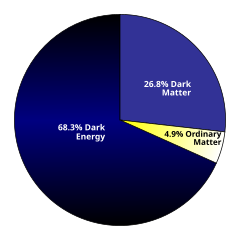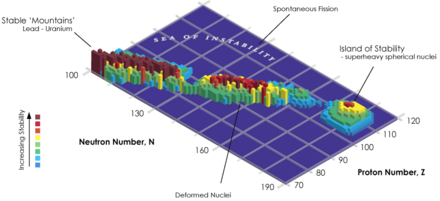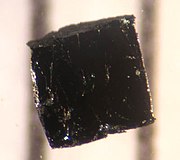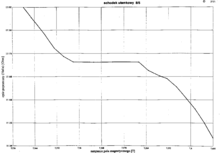Cosmology and general relativity
- Axis of evil: Some large features of the microwave sky at distances of over 13 billion light years appear to be aligned with both the motion and orientation of the solar system. Is this due to systematic errors in processing, contamination of results by local effects, an unexplained violation of the Copernican principle and thus the concordance model, or are these features simply statistically insignificant?
- Fine-tuned universe: The values of the fundamental physical constants are in a narrow range necessary to support carbon-based life.[13][14][15] Is this because there are an infinite number of other universes with different constants, or are our universe's constants the result of chance, or some other factor or process? (See also the anthropic principle.)
- Cosmic inflation: Is the theory of cosmic inflation in the very early universe correct, and, if so, what are the details of this epoch? What is the hypothetical inflaton scalar field that gave rise to this cosmic inflation? If inflation happened at one point, is it self-sustaining through inflation of quantum-mechanical fluctuations, and thus ongoing in some extremely distant place?[16]
- Horizon problem: Why is the distant universe so homogeneous when the Big Bang theory seems to predict larger measurable anisotropies of the night sky than those observed? Cosmological inflation is generally accepted as the solution, but are other possible explanations such as a variable speed of light more appropriate?[17]
- Origin and future of the universe: How did the conditions for anything to exist arise? Is the universe heading towards a Big Freeze, a Big Rip, a Big Crunch, or a Big Bounce?
- Size of universe: The diameter of the observable universe is about 93 billion light-years, but what is the size of the whole universe? Is the universe infinite?
- Baryon asymmetry: Why is there far more matter than antimatter in the observable universe? (This may be solved due to the apparent asymmetry in neutrino-antineutrino oscillations.)[18]
- Cosmological principle: Is the universe homogeneous and isotropic at large enough scales, as claimed by the cosmological principle and assumed by all models that use the Friedmann–Lemaître–Robertson–Walker metric, including the current version of the ΛCDM model, or is the universe inhomogeneous or anisotropic?[19] Is the CMB dipole purely kinematic, or does it signal anisotropy of the universe, resulting in the breakdown of the FLRW metric and the cosmological principle?[19] Is the Hubble tension evidence that the cosmological principle is false?[19] Even if the cosmological principle is correct, is the Friedmann–Lemaître–Robertson–Walker metric the right metric to use for our universe?[20][19] Are the observations usually interpreted as the accelerating expansion of the universe rightly interpreted, or are they instead evidence that the cosmological principle is false?[21][22]
- Copernican principle: Are cosmological observations made from Earth representative of observations from the average position in the universe?
- Cosmological constant problem: Why does the zero-point energy of the vacuum not cause a large cosmological constant? What cancels it out?[23][24][a]

- Dark matter: What is the identity of dark matter?[17] Is it a particle? If so, is it a WIMP, axion, the lightest superpartner (LSP), or some other particle? Or, do the phenomena attributed to dark matter point not to some form of matter but actually to an extension of gravity?
- Dark energy: What is the cause of the observed accelerating expansion of the universe (the de Sitter phase)? Are the observations rightly interpreted as the accelerating expansion of the universe, or are they evidence that the cosmological principle is false?[21][22] Why is the energy density of the dark energy component of the same magnitude as the density of matter at present when the two evolve quite differently over time; could it be simply that we are observing at exactly the right time? Is dark energy a pure cosmological constant or are models of quintessence such as phantom energy applicable?
- Dark flow: Is a non-spherically symmetric gravitational pull from outside the observable universe responsible for some of the observed motion of large objects such as galactic clusters in the universe?
- Shape of the universe: What is the 3-manifold of comoving space, i.e., of a comoving spatial section of the universe, informally called the "shape" of the universe? Neither the curvature nor the topology is presently known, though the curvature is known to be "close" to zero on observable scales. The cosmic inflation hypothesis suggests that the shape of the universe may be unmeasurable, but, since 2003, Jean-Pierre Luminet, et al., and other groups have suggested that the shape of the universe may be the Poincaré dodecahedral space. Is the shape unmeasurable; the Poincaré space; or another 3-manifold?
- Extra dimensions: Does nature have more than four spacetime dimensions? If so, what is their size? Are dimensions a fundamental property of the universe or an emergent result of other physical laws? Can we experimentally observe evidence of higher spatial dimensions?




